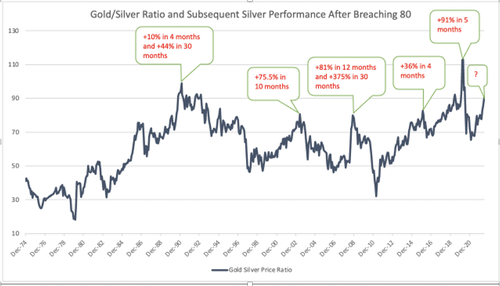
There are reasons to be bullish on silver, not just because of its role as a monetary metal and inflation hedge, but also due to its importance as an industrial metal. Doug Casey recently talked about silver’s many uses and what it means for the future with International Man.
The first question posted to Casey was what makes silver useful and valuable?
Casey said in the first place, silver has historically been money.
Throughout history, three metals have been used as money: gold, silver, and copper. All share the five qualities of good money—durability, divisibility, portability, consistency, and intrinsic value—but in different proportions. All three metals can be bought for the same reasons as well—each is a long-term store of value, a medium of exchange, and an interesting speculation, at least periodically. Gold has always been, and probably always will be used primarily as money. Copper will probably remain an industrial metal. Silver falls neatly in between them both in price, the way it’s used, and where it fits into your investment portfolio. It can be viewed both as a way to save—like gold—and a way to speculate—like copper.”
Silver possesses qualities that make it ideal for use in electronics, medicine, along with other technological applications. It is an extremely important element in the green energy revolution. As Casey pointed out, of the 92 naturally occurring elements, silver is the best conductor of both heat and energy. About 60% of silver is used in industrial applications.
Some argue that a slowing economy will drag silver down. But Casey says that’s not necessarily the case.
If the economy continues to slow down a lot, which I expect as we go into the Greater Depression, industrial metals are likely to get hurt. But silver has a few things that ameliorate that situation. As I said, more high-tech uses are being discovered all the time, helping the consumption side of the equation. The fact that it’s mostly a byproduct of industrial metals means that as their production drops in an economic downturn, the production of silver will drop as well. I’m much more bullish about silver than any other industrial metal—with the possible exception of uranium. At the same time, the fact that it’s a monetary metal is going to bring in a lot of buying from savers and speculators, further supporting its price.”
Casey alluded to the fact that there are very few standalone silver mines. Most silver production is a byproduct of the mining of other metals. This means that economic slowdowns will likely impact the supply side as much as demand.
Global silver production totals about 800 million ounces annually. That compares to about 80 million ounces of gold. But as Casey points out, there are no substantial silver inventories in the world. On the other hand, most of the 6 billion ounces of gold mined over the course of history, are still in existence and being stored somewhere.
If you’re bullish on gold, you should be even more bullish on silver. Silver typically outperforms gold in a gold bull market. And the silver-gold ratio indicates that silver is significantly underpriced when compared to gold. Historically, when the spread gets this wide, silver doesn’t just outperform gold, it goes on a massive run in a short period of time. Since January 2000, this has happened four times. As this chart shows, the snapback is swift and strong.
Casey was asked why silver tends to outperform gold during gold bull runs.
Although about 80 million ounces of gold are produced every year, new production of gold is really unimportant to its price. That’s because all the gold that’s ever been mined, the 6 billion ounces that I mentioned before, is still above ground. What influences its price is the desire of people to hold it—not the roughly 1.3% added to its inventory every year. Gold is almost unique in this regard.
With silver, however, there’s not a huge relative amount of inventory to deal with. I don’t have that number, but it’s basically about new mine production. Silver inventories are in line with other industrial metals—very different from the days when the US government alone owned two billion ounces, not counting the billions more that used to be in US dimes, quarters, halves, and silver dollars. In relative terms, everything about silver is small, and small markets by their nature tend to be volatile.
There’s another thing: For many years, silver has developed a lot of fans who see it almost as a religious icon. Maybe they’re people that can’t afford gold, but silver has always, for some reason, been viewed as almost a magical element by some people, mostly Americans. They’re much more fanatical than gold bugs (among which I have to number myself).”
Casey said he is primarily bullish on silver, along with other commodities, because it is virtually the only sector in the financial markets that hasn’t been in a bubble.
If we get the kind of precious metals bull market that I’m anticipating, mining stocks, particularly silver stocks, could do phenomenally well. We’ll see them move 10-1 as a group, with some doing much better. It will have been worth the wait.”
There are reasons to be bullish on silver, not just because of its role as a monetary metal and inflation hedge, but also due to its importance as an industrial metal. Doug Casey recently talked about silver’s many uses and what it means for the future with International Man.
The first question posted to Casey was what makes silver useful and valuable?
Casey said in the first place, silver has historically been money.
Throughout history, three metals have been used as money: gold, silver, and copper. All share the five qualities of good money—durability, divisibility, portability, consistency, and intrinsic value—but in different proportions. All three metals can be bought for the same reasons as well—each is a long-term store of value, a medium of exchange, and an interesting speculation, at least periodically. Gold has always been, and probably always will be used primarily as money. Copper will probably remain an industrial metal. Silver falls neatly in between them both in price, the way it’s used, and where it fits into your investment portfolio. It can be viewed both as a way to save—like gold—and a way to speculate—like copper.”
Silver possesses qualities that make it ideal for use in electronics, medicine, along with other technological applications. It is an extremely important element in the green energy revolution. As Casey pointed out, of the 92 naturally occurring elements, silver is the best conductor of both heat and energy. About 60% of silver is used in industrial applications.
Some argue that a slowing economy will drag silver down. But Casey says that’s not necessarily the case.
If the economy continues to slow down a lot, which I expect as we go into the Greater Depression, industrial metals are likely to get hurt. But silver has a few things that ameliorate that situation. As I said, more high-tech uses are being discovered all the time, helping the consumption side of the equation. The fact that it’s mostly a byproduct of industrial metals means that as their production drops in an economic downturn, the production of silver will drop as well. I’m much more bullish about silver than any other industrial metal—with the possible exception of uranium. At the same time, the fact that it’s a monetary metal is going to bring in a lot of buying from savers and speculators, further supporting its price.”
Casey alluded to the fact that there are very few standalone silver mines. Most silver production is a byproduct of the mining of other metals. This means that economic slowdowns will likely impact the supply side as much as demand.
Global silver production totals about 800 million ounces annually. That compares to about 80 million ounces of gold. But as Casey points out, there are no substantial silver inventories in the world. On the other hand, most of the 6 billion ounces of gold mined over the course of history, are still in existence and being stored somewhere.
If you’re bullish on gold, you should be even more bullish on silver. Silver typically outperforms gold in a gold bull market. And the silver-gold ratio indicates that silver is significantly underpriced when compared to gold. Historically, when the spread gets this wide, silver doesn’t just outperform gold, it goes on a massive run in a short period of time. Since January 2000, this has happened four times. As this chart shows, the snapback is swift and strong.
Casey was asked why silver tends to outperform gold during gold bull runs.
Although about 80 million ounces of gold are produced every year, new production of gold is really unimportant to its price. That’s because all the gold that’s ever been mined, the 6 billion ounces that I mentioned before, is still above ground. What influences its price is the desire of people to hold it—not the roughly 1.3% added to its inventory every year. Gold is almost unique in this regard.
With silver, however, there’s not a huge relative amount of inventory to deal with. I don’t have that number, but it’s basically about new mine production. Silver inventories are in line with other industrial metals—very different from the days when the US government alone owned two billion ounces, not counting the billions more that used to be in US dimes, quarters, halves, and silver dollars. In relative terms, everything about silver is small, and small markets by their nature tend to be volatile.
There’s another thing: For many years, silver has developed a lot of fans who see it almost as a religious icon. Maybe they’re people that can’t afford gold, but silver has always, for some reason, been viewed as almost a magical element by some people, mostly Americans. They’re much more fanatical than gold bugs (among which I have to number myself).”
Casey said he is primarily bullish on silver, along with other commodities, because it is virtually the only sector in the financial markets that hasn’t been in a bubble.
If we get the kind of precious metals bull market that I’m anticipating, mining stocks, particularly silver stocks, could do phenomenally well. We’ll see them move 10-1 as a group, with some doing much better. It will have been worth the wait.”






